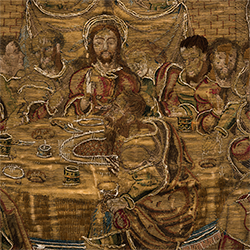
Cope shield.
Western Europe, early 16th c.
Vilnius Cathedral.
15th–16th c. Between the Middle Ages and Renaissance
The predominant style in Lithuania in the late 15th and early 16th century still pointed to the transition from Gothic to Renaissance. The architectural arch, under which individual saints or biblical scenes were represented, no longer framed a figure, but served as a three-dimensional action field. In the Renaissance period, the or nué technique was developed, and the knowledge of perspective drawing and anatomy began to be applied. In Lithuania, the art of embroidery was strongly influenced by the Flemish and German traditions.
Copes
The cope is a sumptuous outer liturgical vestment. It is worn during processions and various liturgical services, with the exception of the Holy Mass. In the beginning, it performed the function of protection from cold in chilly monasteries, and was made from black woollen cloth. The cope has retained a relic of the former mantle protecting from bad weather, the hood, which has become a decorative element.
Images of Christ and scenes from the Gospel
The scene of the Last Judgement is represented on the cope shield. Christ and his twelve disciples are sitting around the table.

